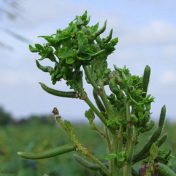A new resistance management strategy (RMS) for Helicoverpa armigera has been released for the northern grain production region. It is anticipated that it will be adopted first in the current chickpea crop. H. armigera is a major pest of grain crops and presents a significant management challenge due to the current reliance on chemical control, and resistance to several insecticide… Read more »
As a part of a new insecticide resistance management strategy in grain crops, growers and agronomists are looking to rotate insecticides for Helicoverpa sp. control. Following enquiries from industry, DAF entomology have been conducting research on the range of newer insecticides available for controlling Helicoverpa larvae. In work previously published on the Beatsheet, we have demonstrated the efficacy of these… Read more »
Phytoplama has been reported in second flower flushes in mungbeans, and also in harvested mungbean regrowth! So far the overall incidence of phytoplasma has been lower than this time last year, but growers and consultants are urged to keep monitoring their crops for the first symptoms of this disease, and to report any outbreaks. Many January-planted mungbean crops are at… Read more »
As more growers and agronomists look to rotate insecticides for helicoverpa control in grain crops as part of a sound resistance management strategy, uncertainty about how to tell if larvae are actually dying, or had escaped control for some reason has emerged as a concern in some instances. These cases, where larvae have not died as quickly as expected, have… Read more »
UPDATE: Crop progress report (March 2018) Recent photos of the crop where a stem fly infestation was reported in early February show signs of stem fly pupation, but no crop stress symptoms (i.e. no yellow and dying leaves), indicating that managing the outbreak when it was first detected would have been a waste of time and money (assuming there will… Read more »
Last summer saw unprecedented levels of phytoplasma in summer pulses/legumes (including chickpeas, mungbeans and pigeon peas) in all cropping regions in eastern and northern Australia from the Ord Irrigation area (WA), Burdekin/Atherton Tablelands (NQ), to central NSW. The most likely insect vector is the brown leafhopper Orosius orientalis, which has been detected in recent (2017) spring crops. While plantings of… Read more »
The Helicoverpa pheromone trapping program has recently concluded for the 2017 Winter/Spring season. The program, run by the Queensland Department of Agriculture and Fisheries for the Northern Grain Growing region, forms part of the national Helicoverpa monitoring network jointly run by cesar, SARDI, and DAFWA. The primary purpose of the trapping network is to detect high moth activity, for both… Read more »
Sorghum is most susceptible to crop loss from insect pests during flowering and grain fill, and this article deals mostly with these species (sorghum midge, helicoverpa and Rutherglen bug). However, some years there may be pest infestations in vegetative sorghum. Vegetative sorghum During the vegetative stages you may see a few armyworm or helicoverpa larvae causing shot-holes in the leaves,… Read more »
Although typically only in low numbers in the Northern Grains region, Rutherglen bugs (RGB; Nysius vinitor) were observed at very high densities (e.g. 50 RGB per pod) in many crops last year. A glasshouse study was conducted to determine at what plant stage mungbeans were most susceptible to RGB damage, in terms of both yield and seed quality. To do… Read more »
Wireworm adults and larvae are relatively common soil pests, attacking all field crops. Adults feed on germinating shoots, and larvae feed on germinating seed, seedling roots and shoots causing poor plant vigour or death. Wireworms are most common in zero till, areas with high stubble, or weedy fallows. These are habitats and food sources that sustain the beetles and enable… Read more »









